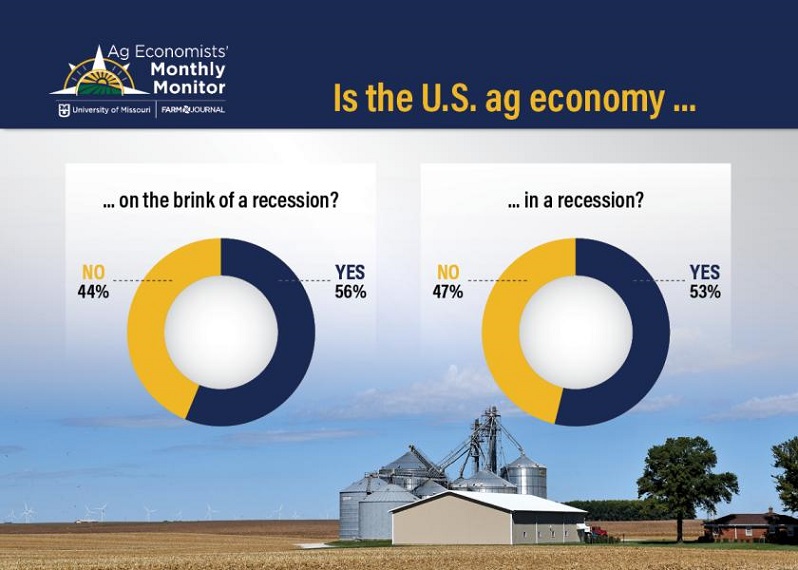
U.S. corn prices hit a four-year low as the prospect for record corn and soybean crops takes shape in the field. The eroding outlook also appeared in the August Ag Economists’ Monthly Monitor as more economists are concerned U.S. agriculture is either already in a recession or on the brink of one, but economists point out if it weren’t for strong cattle prices, the ag economic picture would look even worse.
“When you look at, what we said for both, relative to last month or last year, some of the most pessimistic readings we’ve had, since we’ve been surveying here on 2024,” said Scott Brown, interim director, Rural and Farm Finance Policy Analysis Center (RaFF), University of Missouri who also helps author the Monthly Monitor each month.

The latest Ag Economists’ Monthly Monitor tried to get a better gauge of the risk of financial stress in agriculture, and asked the more than 70 economists surveyed if agriculture is on the brink of a recession. Nearly 60% said “yes.”
“Maybe what was even more surprising to me is the responses to the question, ‘Are we already in a recession?’ More than 50% said ‘yes, we’re already in a recession.’ That’s a big change from where we were just 16 to 24 months ago, and it shows a lot of folks are worried about where we sit today.”
The Monthly Monitor also asked economists to provide more explanation of why they think the U.S. ag economy is already in a recession. Economists said:
- “At least for most crop producers, the sharp drop in prices and cash receipts has resulted in lower net income and financial pressure on leveraged producers. The picture is generally less dire on the animal agriculture side of the ledger, as prices are up (cattle, milk) for some commodities and feed costs are declining.”
- “I do think the U.S. ag economy is in a recession. The projection for 2023 and 2024 farm incomes in real dollars are the two largest declines in history. Costs exceed prices for most commodities. And the outlook doesn’t provide indication of improvement soon.”
- “Farm incomes are down. Ag manufacturers are laying people off. Suppliers for those manufacturers are laying people off. What are the bright spots? Cattle, depending on the segment? Trade with Mexico? After that, the list gets pretty thin.”
- “We aren’t in one yet, but we are on the brink of one.”
- I think we’ll enter into a recession after the election.”
Cattle Are Helping the Overall Ag Economic Picture
As the concerns about the ag economy pour in, Brown points out the net farm income situation would look even worse if it weren’t for more positive prices in livestock.
“Cattle prices, I think, have been helpful in pulling it up. At the same time, we see corn and soybean prices continue to move lower,” Brown says. “We know crop receipts are going to be lower than what they would have said back at the start of the year, cattle probably higher, hogs probably higher and dairy probably higher. But economists also expect production expenses to not go up from where they were originally during the first part of the year.”
Net Farm Income Could Fall Further
U.S. Department of Agriculture’s (USDA) Economic Research Service (ERS) gave its first glimpse at 2024 Net Farm Income in February with the Farm Sector Income & Finances: Farm Sector Income Forecast. At that time, USDA ERS’ forecast showed net farm income to fall after reaching record highs in 2022.
USDA ERS’ forecasts showed:
· Net farm income, which is a broad measure of profits, reached $185.5 billion in calendar year 2022 in nominal dollars.
· After decreasing by $29.7 billion (16.0%) from 2022 to a forecast $155.9 billion in 2023, net farm income in 2024 is forecast to decrease further from the 2023 level by $39.8 billion (25.5%) to $116.1 billion.
· Net cash farm income reached $202.3 billion in 2022. After decreasing by $41.8 billion (20.7%) from 2022 to a forecast $160.4 billion in 2023, net cash farm income is forecast to decrease by $38.7 billion (24.1%) to $121.7 billion in 2024.

ERS will provide an updated 2024 forecast in September. Even with improvements in livestock margins, the August Ag Economists’ Monthly Monitor showed the majority of ag economists expect the further deterioration in crop prices to weigh on the overall net farm income picture and force the agency to revise their forecast lower.
· Nearly 57% expect USDA to revise its forecast
· 36% think the revision will be 5% to 10% lower
· 7% think USDA will leave its forecast unchanged from February.
What Will Impact Crop Prices Over Next 6 Months
The August Monthly Monitor also asked economists to outline what will impact crop prices over the next six months. Economists said:
- Growing crop size and limited exports
- Bioenergy and feed demand
- South America’s weather and crop size, specifically the second crop final production numbers and plantings for the first crop
- Potential for new tariffs and relations with China
- Fertilizer prices and the impact on 2025 acreage.
What Will Impact Cattle Prices Over Next 6 Months
With a more bullish outlook for cattle, the August survey asked economists what will impact cattle prices over the next six months.
- Weaker demand
- Lower corn prices
- Possibility of tighter cattle numbers
“I think the supply fundamentals are essentially unchanged since this spring. The big question is demand. If we have an economy-wide recession, what happens to beef demand,” responded one economist in the anonymous monthly survey.
What to Watch
From geopolitics to the evolving situation in supply and demand across all commodities, the Monthly Monitor asked economists to outline the factors not being covered enough in the media.
- “Deterioration in liquidity.”
- “Growing gap between the situation for crop and livestock producers.”
- “Impact of a Trump vs. Harris win and misconceptions around who is better for the farm economy.”
- “Continued high cost for many ag inputs.”
- “I’m frustrated by the continued pressure on U.S. farmers to be more sustainable which often results in higher farm costs and could lead to more regulation or hoops to jump through or reduced production. At the same time, South American producers continue to rapidly expand production in a less sustainable way. I’m also concerned that this will lead to vertical integration in crop farming.”
- “The cataclysmic risk of rising tariffs.”
- “Will congress set in to support farm incomes at these levels? ARC/PLC are ineffective at this point. Ad hoc spending has been rampant.”
- “Inflation.”
- “Possible government farm program payments this fall (last year’s crop year).”
- “Fund manager use of Algo computers.”
You can now read the most important #news on #eDairyNews #Whatsapp channels!!!
🇺🇸 eDairy News INGLÊS: https://whatsapp.com/channel/0029VaKsjzGDTkJyIN6hcP1K




















